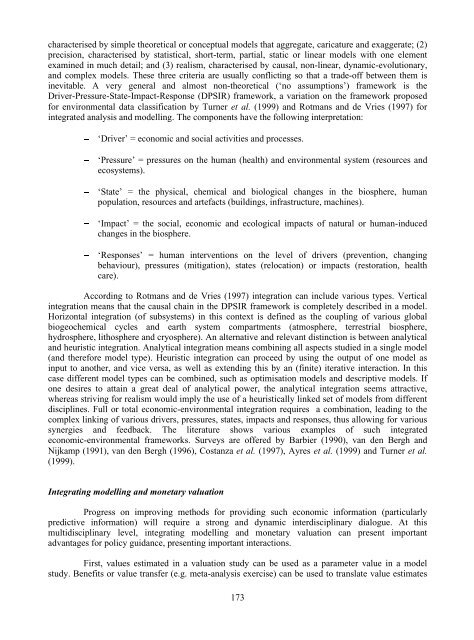characterised by simple theoretical or conceptual models that aggregate, caricature and exaggerate; (2)precision, characterised by statistical, short-term, partial, static or linear models with one elementexamined in much detail; and (3) realism, characterised by causal, non-linear, dynamic-evolutionary,and complex models. These three criteria are usually conflicting so that a trade-<strong>of</strong>f between them isinevitable. A very general and almost non-theoretical (‘no assumptions’) framework is theDriver-Pressure-State-Impact-Response (DPSIR) framework, a variation on the framework proposedfor environmental data classification by Turner et al. (1999) and Rotmans and de Vries (1997) forintegrated analysis and modelling. The components have the following interpretation:- ‘Driver’ = economic and social activities and processes.- ‘Pressure’ = pressures on the human (health) and environmental system (resources andecosystems).- ‘State’ = the physical, chemical and biological changes in the biosphere, humanpopulation, resources and artefacts (buildings, infrastructure, machines).- ‘Impact’ = the social, economic and ecological impacts <strong>of</strong> natural or human-inducedchanges in the biosphere.- ‘Responses’ = human interventions on the level <strong>of</strong> drivers (prevention, changingbehaviour), pressures (mitigation), states (relocation) or impacts (restoration, healthcare).According to Rotmans and de Vries (1997) integration can include various types. Verticalintegration means that the causal chain in the DPSIR framework is completely described in a model.Horizontal integration (<strong>of</strong> subsystems) in this context is defined as the coupling <strong>of</strong> various globalbiogeochemical cycles and earth system compartments (atmosphere, terrestrial biosphere,hydrosphere, lithosphere and cryosphere). An alternative and relevant distinction is between analyticaland heuristic integration. Analytical integration means combining all aspects studied in a single model(and therefore model type). Heuristic integration can proceed by using the output <strong>of</strong> one model asinput to another, and vice versa, as well as extending this by an (finite) iterative interaction. In thiscase different model types can be combined, such as optimisation models and descriptive models. Ifone desires to attain a great deal <strong>of</strong> analytical power, the analytical integration seems attractive,whereas striving for realism would imply the use <strong>of</strong> a heuristically linked set <strong>of</strong> models from differentdisciplines. Full or total economic-environmental integration requires a combination, leading to thecomplex linking <strong>of</strong> various drivers, pressures, states, impacts and responses, thus allowing for varioussynergies and feedback. The literature shows various examples <strong>of</strong> such integratedeconomic-environmental frameworks. Surveys are <strong>of</strong>fered by Barbier (1990), van den Bergh andNijkamp (1991), van den Bergh (1996), Costanza et al. (1997), Ayres et al. (1999) and Turner et al.(1999).Integrating modelling and monetary valuationProgress on improving methods for providing such economic information (particularlypredictive information) will require a strong and dynamic interdisciplinary dialogue. At thismultidisciplinary level, integrating modelling and monetary valuation can present importantadvantages for policy guidance, presenting important interactions.First, values estimated in a valuation study can be used as a parameter value in a modelstudy. <strong>Benefits</strong> or value transfer (e.g. meta-analysis exercise) can be used to translate value estimates173
to other contexts, conditions, locations or temporal settings that do not allow for direct valuation in‘primary studies’ (due to technical or financial constraints).Second, models can be used to generate values under particular scenarios. In particular,dynamic models can be used to generate a flow <strong>of</strong> benefits over time and to compute the net presentvalue, which can serve as a value relating to a particular scenario <strong>of</strong> ecosystem change ormanagement.Third, models can be used to generate detailed scenarios that enter valuation experiments.An input scenario can describe a general environmental change, regional development or ecosystemmanagement. This can be fed into a model calculation, which in turn provides an output scenario withmore detailed spatial or temporal information. The latter can then serve, for example, as a hypotheticalscenario for valuation, which is presented to respondents in a certain format (graphs, tables, story,diagrams, pictures) so as to inform them about potential consequences <strong>of</strong> the general policy orexogenous change. Computer s<strong>of</strong>tware can be used in such a process. Finally, the output <strong>of</strong> model andvaluation studies can be compared. For instance, when studying a scenario for wetland transformationone can model the consequences in multiple dimensions (physical, ecological and costs/benefits), andaggregate these via a multi-criteria evaluation procedure, with weights being set by a decision-makeror a representative panel <strong>of</strong> stakeholders. Alternatively, one can ask respondents to provide valueestimates, such as a willingness to pay for not experiencing the change. If such information isavailable for multiple management scenarios, then rankings based on either approach can becompared. So far no empirical study has accomplished this.Conclusions and recommendationsHow can we use the ideas presented in Sections 2, 3 and 4 to formulate an integrated,effective framework for the economic valuation <strong>of</strong> biodiversity? And what do we learn from theempirical valuation studies focused on biodiversity? A crucial, and initial step, is to carefully describethe object <strong>of</strong> analysis and valuation. Therefore, researchers face two important decisions when valuingbiodiversity: (1) at which level should biodiversity be examined; and, (2) what biodiversity valuetypes should be measured?Clearly, it is necessary to attain information about the nature, type, and persistence <strong>of</strong> stressor shocks experienced by ecosystems, their functions and stability, and respective impacts on humanwelfare. A comprehensive assessment <strong>of</strong> ecosystem biodiversity characteristics, structure andfunctioning requires the analyst to undertake various important actions. First, the causes <strong>of</strong>biodiversity loss should be determined, in order to improve understanding <strong>of</strong> socio-economic impactson biodiversity processes and attributes. Second, the range and degree <strong>of</strong> biodiversity functioningshould be assessed, especially in terms <strong>of</strong> ecosystem-functional relationships. Third, the sustainability<strong>of</strong> biodiversity uses should be assessed and the consequences <strong>of</strong> biodiversity loss should bedetermined. Finally, alternative biodiversity management strategies should be assessed and spatial andtemporal systems analysis <strong>of</strong> alternative biodiversity conservation scenarios should be carried out.Ecologists contribute to identification <strong>of</strong> the range <strong>of</strong> policy decisions with respect to thebiodiversity strategies, by exploring the use <strong>of</strong> ecological valuation methods such as red data specieslists and biological value indexes. More recently, computer models have <strong>of</strong>ten been used by ecologiststo aid conservation evaluation decisions, namely in the domain <strong>of</strong> species population. Several generalmodels have been developed for this task and applied, for example, to calculate the dimension <strong>of</strong> ageographic area <strong>of</strong> suitable habitat required to support the minimum viable population (e.g., the giantpanda). Finally, computer models have also been used for habitat evaluation with the objective <strong>of</strong>simulating the impact <strong>of</strong> different development scenarios and predicting the respective ecological174
- Page 1 and 2:
«ENVIRONMENTValuation ofBiodiversi
- Page 3 and 4:
ORGANISATION FOR ECONOMIC CO-OPERAT
- Page 5 and 6:
TABLE OF CONTENTSPART 1 ...........
- Page 7 and 8:
PART 4 ............................
- Page 10 and 11:
Why value biodiversity?There are th
- Page 12 and 13:
Figure 1.1 Total economic value: us
- Page 14 and 15:
from biodiversity at the local leve
- Page 16 and 17:
in the database and also for undert
- Page 18 and 19:
in the policy context. This is high
- Page 20:
Table 1.3 Policy Options for the Cl
- Page 23 and 24:
Box 1.2 Value of Turkey’s Forests
- Page 25 and 26:
of the most important implications
- Page 27 and 28:
Additionally, valuation does not ju
- Page 29 and 30:
value is the habitat, many differen
- Page 31 and 32:
are very modest. More recently, new
- Page 33 and 34:
Table 2.2 Estimates of the Medicina
- Page 35 and 36:
The importance of indirect use valu
- Page 37 and 38:
pharmaceutical use, although the li
- Page 39 and 40:
McAllister, D., (1991). Estimating
- Page 41 and 42:
Simpson, D and Craft, A.. (1996).
- Page 43 and 44:
practice, the overlap between these
- Page 45 and 46:
aimed at giving more precise quanti
- Page 47 and 48:
structural values. There are a numb
- Page 49 and 50:
Reid (forthcoming) discusses the po
- Page 51 and 52:
Ecotourism as a Way to Generate Loc
- Page 53 and 54:
endangered Indian rhino and other t
- Page 55 and 56:
ReferencesBann, C., and M. Clemens
- Page 57 and 58:
PART 261
- Page 59 and 60:
many European countries, CBA has a
- Page 61 and 62:
(1) Cost and time constraintsThe co
- Page 63 and 64:
activity day, there is greater vari
- Page 65 and 66:
added independent variable C s= cha
- Page 67 and 68:
error in valuing respiratory sympto
- Page 69 and 70:
ReferencesArrow, K.J., R. Solow, E.
- Page 71 and 72:
OECD (1995). The Economic Appraisal
- Page 73 and 74:
CHAPTER 5:by José Manuel LIMA E SA
- Page 75 and 76:
linkages usually lead to diverse co
- Page 77 and 78:
A discrete choice approach to quest
- Page 79 and 80:
Table 5.2 Model-based point estimat
- Page 81 and 82:
is potentially very large for multi
- Page 83 and 84:
P3 is already in the mix is 2.51, s
- Page 85 and 86:
PART 391
- Page 87 and 88:
measures of value. An appendix to t
- Page 89 and 90:
features (such as parks, beaches or
- Page 91 and 92:
included in cost-benefit analysis o
- Page 93 and 94:
A Discussion of Past Efforts to Dev
- Page 95 and 96:
Satellite AccountsIn addition to th
- Page 97 and 98:
which many people argue are associa
- Page 99 and 100:
approach to competing uses of water
- Page 101 and 102:
Figure 6.2 Trade-Off AnalysisEnviro
- Page 103 and 104:
However, the farmers need not bear
- Page 105 and 106:
Appendix 1: Theory and Application
- Page 107 and 108:
iwhere C is the income adjustment n
- Page 109 and 110:
complete. If there are more than on
- Page 111 and 112:
Horowitz, Joel. L. and Jordan. J. L
- Page 113 and 114: CHAPTER 7:by Dennis M. KING and Lis
- Page 115 and 116: Box 7.1 Definition of terms related
- Page 117 and 118: Box 7.2 Categories of Ecosystem Ser
- Page 119 and 120: Box 7.4 Dollar-based ecosystem valu
- Page 121 and 122: Non-monetary indicators of ecosyste
- Page 123 and 124: Figure 7.1 Effects of Wetland Locat
- Page 125 and 126: description, and that the usefulnes
- Page 127 and 128: 2) Service capacity sub-indexIndica
- Page 129 and 130: wetlands, for example, results in F
- Page 131 and 132: (1) Functional CapacityIndexFigure
- Page 133 and 134: constituents of runoff can be predi
- Page 135 and 136: Service(on or off site)Recreational
- Page 137 and 138: Table 7.3 Service Risk Sub-index De
- Page 139 and 140: Measuring Service Preference Weight
- Page 141 and 142: Table 7.4 Illustration of Paired Co
- Page 143 and 144: PART 4151
- Page 145 and 146: Ecological foundations for biodiver
- Page 147 and 148: Phenotic diversity is a measure bas
- Page 149 and 150: Operationalisation of the biotic-ri
- Page 151 and 152: ten attributes that could score a m
- Page 153 and 154: The choice of the scale relates to
- Page 155 and 156: Nature measurement methodIn 1995, t
- Page 157 and 158: Table 8.4 Value orientations and en
- Page 159 and 160: Table 8.5 Identification of monetar
- Page 161 and 162: Table 8.6 Valuation studiesSingle s
- Page 163: in waterway systems for nine impact
- Page 167 and 168: ReferencesAkcakaya, H.R. (1994).
- Page 169 and 170: de Groot, R.S. (1994). “Environme
- Page 171 and 172: Mace, G. M. & S. N. Stuart. (1994).
- Page 173 and 174: Turner, R.K., Perrings, C. and Folk
- Page 175 and 176: John A. DixonJohn A. Dixon is Lead
- Page 177 and 178: Robert O’NeillDr. O’Neill recei
- Page 179 and 180: Steven StewartSteven Stewart is Ass
- Page 181: OECD PUBLICATIONS, 2, rue André-Pa












